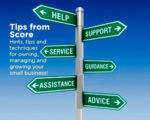Marketing Customer Service
 Question: I have been told that my customer service needs some attention. Any tips?
Question: I have been told that my customer service needs some attention. Any tips?
Answer: Nothing substitutes for great customer service. It is the lifeblood of a small business. And, it can be the differentiator between you and your competition. Many more customers leave their preferred provider due to poor customer service than over price. In fact, only 1/3 of customers who have a bad experience complain. So, how do you know? Ask. Good customer service can retain and even give rise to having past customers return after a less than stellar experience. If you are a good salesperson, you can sell anything to anyone once, but if they don’t receive great interaction post-sale, it will be a one and done sale. Consider these tips:
Answer the phone – An unanswered phone just says, “We don’t care.” Have call forwarding to your cell phone, subscribe to your phone provider’s voice mail service or buy an answering machine. Then return the call within the workday. If you have heavy phone traffic, hire temp staff just to answer the phone and take messages or teach them a preliminary response to FAQs. If possible have a live person answer your phone.
Don’t promise what you cannot do – If you cannot call back within the workday, but can within 24 hours, say so on your outgoing VM message. Don’t make promises you cannot keep. If you say you are going to be at a prospect’s house at 9 am to do a quote and you cannot get there, for whatever reason, until 9:30 am, either find another day and time or say so upfront. If you cannot get to a client this week as they desired to have a tree removed, but can get to it next week, say so upfront.
Listen, Listen, and Listen – Steven Covey in his “7 Habits…advises to listen with the intent to understand, not just reply. Good customer service starts with understanding the needs of the customer and we cannot do that by doing all the talking. We have to consciously listen to our customers and prospects. We can learn a lot by just listening.
Deal immediately with complaints – The best time to deal with complaints is when they are identified. No one likes to hear them, but acknowledge them, address them and position your business as responsive to customer needs both positive and negative.
Adopt a “helping” culture – There may not be any immediate payback, but offering a helping hand creates a positive image for your brand. Even if it is not in your mainstream, but it helps a customer or prospect, they will tell others. And, word-of-mouth is still the best method of marketing.
Make training your staff a pillar of success – Take the time to onboard new staff, so they are knowledgeable about your business philosophy. If a retail business, make sure new staff understand your stocking and return policies and how important being helpful and courteous are to the customer experience. Do the training yourself so your employees understand your commitment to good customer service. By training them, you are empowering them to make positive customer interacting decisions.
Give them something extra – When shopping at GreenSpot in South Yarmouth, you get a coupon for purchases from May 1 through June 30th that you can redeem from August 1st to September 6th and between November 25th and December 5th. Collect the Bucks for future discounts.
Everyone loves them. They produce a smile and benefits the business in continuing the loyalty to the GreenSpot brand.
Go the extra mile – Take a page from Home Depot by escorting a customer to the exact location to find what they are seeking vs. “it’s on aisle 4”. If you don’t carry something teach your staff to ask you or someone more knowledgeable where they might find what they are seeking. If they are seeking directions to a location, write down the directions or look it up on MapQuest and print it out. Going the extra mile says, “I care.”
Customers can be broken down into five categories. Loyal customers they statistically represent 20% of a customer base, but 50% of revenue. Discount customers they shop frequently, but are price buyers. Impulse buyers they buy on a whim. Need-based customers they have a specific need and shop for it and only it. Wandering customers they are interested in the experience without a specific need. Each requires a different approach to service. Knowing who is buying and their motivations will help you and your staff focus on what will work with each type of customer.
You want to earn dividends by providing good customer service. You can sell a product or service once. If you want to sell it twice, provide great customer service. It produces good will, word-of-mouth promotion and the continued growth of your small business.











